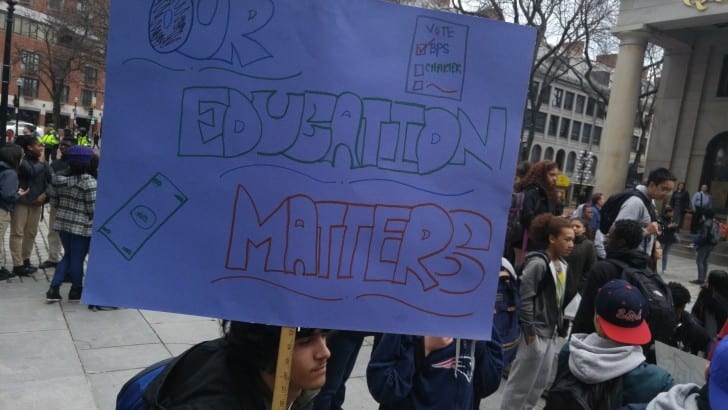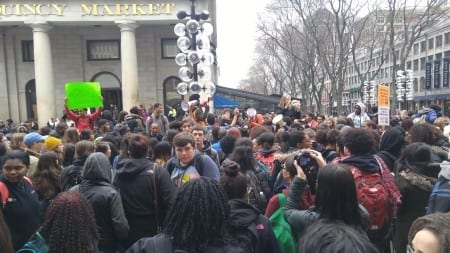![Students at rally at Boston City Hall by NewtonCourt (Own work) [CC BY-SA 4.0], via Wikimedia Commons](http://1fkoby17rlj41m4giv3x4cvk-wpengine.netdna-ssl.com/wp-content/uploads/2017/10/Students_at_rally_at_Boston_City_Hall_144819274-1.jpg)
Students at rally at Boston City Hall by NewtonCourt (Own work) [CC BY-SA 4.0], via Wikimedia Commons
From the guy that brings you Apparent Horizon
October 18, 2017
BY JASON PRAMAS @JASONPRAMAS
The rich and powerful interests that control Massachusetts politics and the state economy have their fingers in every conceivable pie. So numerous are their projects that it’s difficult for most news outlets to keep track of them, let alone cover them all. Yet it’s critical for our democracy that they be covered. Which is why I’m launching Townie—a regular news column that will provide short takes on all the elite wheeling and dealing that most people never hear about.
Business Organizations Sue to Down “Millionaire’s Tax” Referendum
In an era when taxes continue to be slashed for wealthy people and corporations as government social programs are starved for funds, one would think that the Fair Share Amendment (a.k.a. “millionaire’s tax”) proposed by the Raise Up Massachusetts coalition of religious, labor, and community organizations would be a no-brainer. The idea is slated to be put in front of Massachusetts voters as a binding referendum question in November 2018. If passed, it would amend the state constitution to add a 4 percent tax on top of the Bay State’s infamously inadequate 5.1 percent flat income tax for all households earning $1 million or more. The money collected will be mandated to fund public schools, transportation, and road maintenance. All sectors that really need the money. And best of all, only 19,500 families would have to pay in 2019 if the tax goes into effect—0.5 percent of all filers.
Well apparently any tax is a bad tax in the eyes of the Commonwealth’s “business community.” No matter how many people it would help, and how painless it would be for the tiny number of 0.5 percenters. So, according to an Associated Industries of Massachusetts (AIM) press release, the leaders of five pro-corporate organizations are trying to torpedo the referendum before it can be voted on by filing a lawsuit against it at the Supreme Judicial Court. The plaintiffs are: Christopher Anderson, president of the Massachusetts High Technology Council, Inc. (MHTC); Christopher Carlozzi, Massachusetts state director of the National Federation of Independent Business (NFIB); Richard Lord, president and chief executive officer of AIM; Eileen McAnneny, president of the Massachusetts Taxpayers Foundation (MTF); and, Daniel O’Connell, president and chief executive officer of the Massachusetts Competitive Partnership (MACP).
They claim that the referendum language is “riddled with constitutional flaws,” with the MTHC’s Anderson remarking that “Amending the Constitution to achieve taxing and spending by popular vote is just a terrible idea, and could undo much of the good work that Massachusetts has done in terms of creating a successful economic climate.” But no matter what kinds of arguments they try to make, it seems like what they’re most afraid of is democracy. Let’s see how far they get with the SJC.
About That Opioid Epidemic…
More proof that the rising number of deaths from opioid abuse has more to do with corporate greed than any personal failings of individuals suckered into addiction by pliant doctors colluding with pharma sales reps. And also that those few drug companies that pay any penalty at all for their role in destroying communities across the state, get little more than a slap on the wrist. According to a press release by the office of Mass Attorney General Maura Healey, “An opioid manufacturer will pay $500,000 to resolve allegations that it engaged in a widespread scheme to unlawfully market its fentanyl spray and paid kickbacks to providers to persuade them to prescribe the product… Insys Therapeutics, Inc. misleadingly marketed Subsys, a narcotic fentanyl product that is sprayed under a patient’s tongue.” The money will be used to “help fund the AG’s prevention, education and treatment efforts.”
Fentanyl is a synthetic opioid that is 30-50 times more powerful than heroin. The company claimed its spray version of the drug was useful for treating “minor” pain in non-cancer patients—despite the fact that the FDC had only approved the drug for use in more severe pain in cancer patients. It then pushed its sales staff to give kickbacks to doctors in the form of “fees paid to speak to other health care providers about the product.”
Boondoggle in Progress?
When a public college gets involved in land deals, it’s definitely worth keeping an eye on. Especially when that college is UMass—a troubled multi-campus institution whose leadership would rather engage in property speculation than fight the legislature for more money for public higher education.
In 2010, the school’s independent development wing, the UMass Building Authority (UMBA), bought the former Bayside Expo Center property after its owners went into foreclosure. According to the Dorchester Reporter, in August, the UMBA issued “a Request for Information (RFI) as it seeks out ideas for the ‘highest and best use’ of the former Bayside Expo Center site on Columbia Point in Dorchester with an eye toward transforming the 20-acre site into a ‘modern-day Harvard Square.’”
Last week, the newspaper reported that 16 developers have responded to the university’s request, including: Accordia Partners; American Campus Communities; Beacon Capital Partners; Bracken Development; Capstone Development Partners LLC & Samuels & Associates; Corcoran Jennison & BTUHWF Building Corp; Core Investment Inc.; Hunt Development Group, LLC & Drew Company Inc.; The HYM Investment Group, LLC; LendLease; Lincoln Property Company; Lupoli Companies; Rhino Capital & Ad Meliora; SKANSKA; University Student Living; and Waterstone Properties Group Inc. The Reporter says the UMass Building Authority “hopes to leverage public-private partnerships toward the massive mixed-use project.” Which usually means big public giveaways to corporations. One way or the other. Stay tuned.
Townie is syndicated by the Boston Institute for Nonprofit Journalism. Jason Pramas is BINJ’s network director, and executive editor and associate publisher of DigBoston. Copyright 2017 Jason Pramas. Licensed for use by the Boston Institute for Nonprofit Journalism and media outlets in its network.







